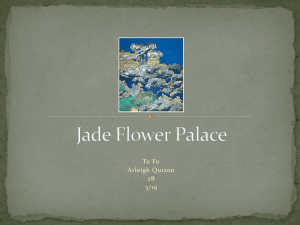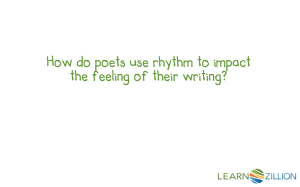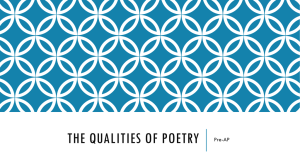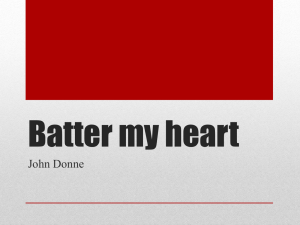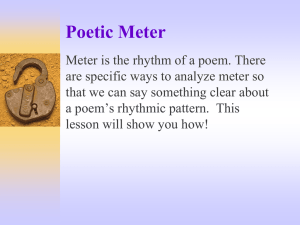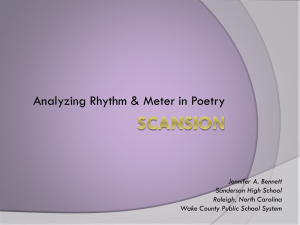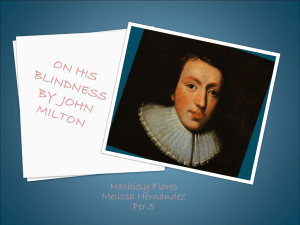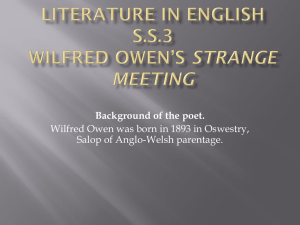POETRY
advertisement
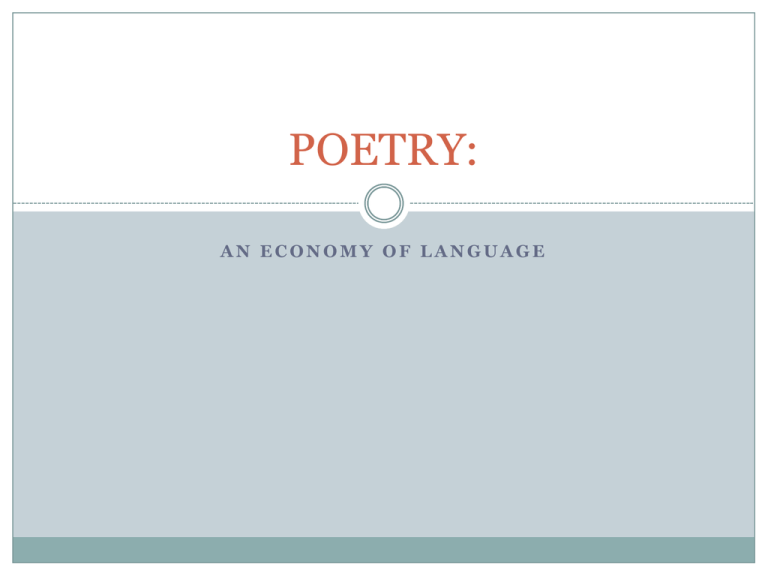
POETRY: AN ECONOMY OF LANGUAGE What does “Economy of Language” Mean? Poetry allows us to say a lot by using only a few words. In poetry, every word is very carefully chosen in order to convey meaning. Poems are ABOUT words. Word choice is far and away the most important aspect of a poem. We know that we’ve found an effective poem when taking out any word would change the meaning or tone of the poem. “Poems are the glowing bones of language.” -Baron Wormser and David Cappella THE ELEMENTS OF POETRY Rhyme Rhythm/ Foot and Meter Tone Symbolism (includes Metaphor, Allegory, Allusion, Simile, etc.) Theme/Meaning What Makes a Poem? Ezra Pound’s “In a Station of the Metro” “In a Station of the Metro” The apparition of these faces in the crowd; Petals on a wet, black bough. RHYME The repetition of different sounds within words in order to create a sense of unity and order within a poem. RHYME Roses are red Violets are blue When I walk into this room It feels like a zoo In this poem, “blue” and “zoo” rhyme, creating a repetition of sounds that are pleasing to the ear. RHYTHM/ FOOT & METER The beat, pace, or “flow” of words within a line or stanza. Meter and foot are how the lines are planned out (terms like “iambic pentameter” that we will look at later). Literally, rhythm dictates how the poem will sound when spoken aloud. Many different factors influence the rhythm of a poem, including the length of words, the accented syllables of words, the length of lines themselves, and the length of stanzas. RHYTHM The whiskey on your breath Could make a small boy dizzy; But I hung on like death: Such waltzing was not easy. We romped until the pans Slid from the kitchen shelf; My mother's countenance Could not unfrown itself. (from “My Papa’s Waltz” by Theodore Roethke) In this example, the whole stanza is in a constant sound pattern, mimicking that of an actual waltz. Some poems speed up, slow down, etc., based on the rhythm and meter; this one stays pretty constant. RHYTHM: Foot and Meter FOOT: layout of accented syllables iamb -- one unaccented or weakly accented syllable followed by one strong accent (ex: my head was hot) trochee -- one strong accent followed by one weak or unaccented syllable, (ex: dreadful) anapest -- two weakly accented syllables followed by one strong stress (ex: at the time of the President's lunch) dactyl -- one strong stress, followed by two weakly accented or unaccented syllables (ex: See in the dark what the officer's doing there) spondee -- two hard stresses in successive syllables (ex: Drop dead! ) RHYTHM: Foot and Meter, cont’d METER: Number and structure of “feet” in a line of poetry. one foot is a monometer, 2 feet is a dimeter, and so on -- trimeter (3), tetrameter (4), pentameter (5), hexameter (6), heptameter (7), and octameter (8). Put it together: a poem in which each line has five iambs (pairs of a weakly accented syllable followed by a strongly-accented syllable) would be said to be written in iambic pentameter. RHYTHM: Foot and Meter, cont’d EXAMPLES: iambic pentameter (5 iambs, 10 syllables) : That time | of year | thou mayst | in me | behold trochaic tetrameter (4 trochees, 8 syllables) : Tell me | not in | mournful | numbers anapestic trimeter (3 anapests, 9 syllables): And the sound | of a voice | that is still dactylic hexameter (6 dactyls, 17 syllables; a trochee replaces the last dactyl): This is the | forest pri | meval, the | murmuring | pine and the | hemlocks TONE The feeling generated within the reader, based on the word choice and rhythm of a poem. This is a tough concept to try to analyze, but we know how a poem makes us feel when we hear it. TONE Ah, distinctly I remember it was in the bleak December, And each separate dying ember wrought its ghost upon the floor. Eagerly I wished the morrow; - vainly I had sought to borrow From my books surcease of sorrow - sorrow for the lost Lenore For the rare and radiant maiden whom the angels named Lenore Nameless here for evermore. (from Edgar Allan Poe’s “The Raven”) Obviously, the tone here is a dark one; a good word to use would be “foreboding”. The choice of words – “bleak December,” “dying ember,” “ghost,” “sorrow” – helps create this feeling within the reader. SYMBOLISM How words and images are used in place of other words and images, in order to convey a deeper meaning. Allusion, allegory, metaphor, and simile are all different kinds of symbolism, but would also fall under this category. SYMBOLISM Ah Sunflower, weary of time, Who countest the steps of the sun; Seeking after that sweet golden clime Where the traveller's journey is done; Where the Youth pined away with desire, And the pale virgin shrouded in snow, Arise from their graves, and aspire Where my Sunflower wishes to go! (William Blake’s “The Sunflower”) In this poem, the sunflower is a metaphor for the passage of life. We will take a closer look at specific examples of allegory, simile, allusion, and metaphor later this year. THEME The meaning that the reader derives from the poem; what the reader interprets the poem to be about. THEME I think I should have loved you presently, And given in earnest words I flung in jest; And lifted honest eyes for you to see, And caught your hand against my cheek and breast; And all my pretty follies flung aside That won you to me, and beneath your gaze, Naked of reticence and shorn of pride, Spread like a chart my little wicked ways. I, that had been to you, had you remained, But one more waking from a recurrent dream, Cherish no less the certain stakes I gained, And walk your memory's halls, austere, supreme, A ghost in marble of a girl you knew Who would have loved you in a day or two. (“I think I should have loved you presently,” by Edna St. Vincent Millay) Although meaning can be subjective and interpretive, most readers would agree that this poem is “about” a woman who has regrets over how she treated an ex-boyfriend while they were still together. There are no “wrong answers” when it comes to interpretation… but there are “foul balls.” Let’s try to keep all our interpretations “in play,” shall we? So, now back to Ezra Pound… “In a Station of the Metro” The apparition of these faces in the crowd; Petals on a wet, black bough. fin



